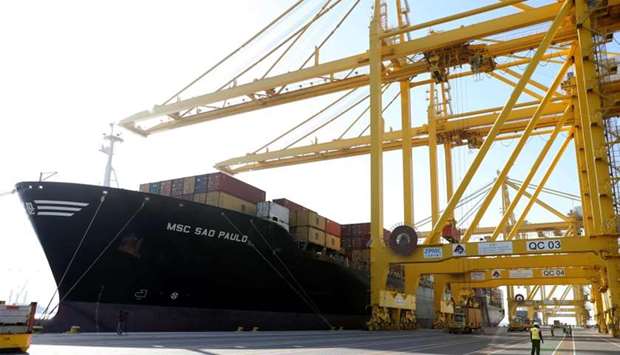Hamad Port is to be officially inaugurated in the first week of September, under the auspices of His Highness The Emir Sheikh Tamim bin Hamad al-Thani, the Ministry of Transport and Communications (MoTC) announced.
Located in Umm al Houl area of southern part of Qatar, Hamad port will represent a paradigm shift in Qatar’s economic diversification and competitiveness in line with the goals of the Qatar National Vision 2030.
A MoTC statement explained that Hamad Port, the largest in the Middle East, spans an area of 28.5sq km. Its basin is 4km long, 700m wide and 17m deep; the specifications that qualify it to become capable of receiving large mother vessels.
The capacity of Hamad Port is to reach 7.5mn twenty-foot equivalent unit (TEU) annually on completion of all phases of construction. It has a general cargo terminal with a capacity of 1.7mn tonnes annually, a terminal for cereals with a capacity of 1mn tonnes annually, and another one to receive vehicles with a capacity of 500,000 vehicles annually. It also has a terminal for livestock, one for coastguard vessels and a terminal for marine support and backup, according to the statement.
Hamad Port applies the highest standards of safety and security and includes a uniquely designed Port Control Tower at a height of 110m, a customs inspection area for rapid cargo clearance (5,600 containers per day), a ship inspection platform and multiple maritime facilities, in addition to other utilities such as storage units, mosques, rest areas, medical clinics and the offices required for port operation.
Moreover, the latest technologies for the operations of the port are being deployed and used for the first time in Qatar and the region.
Additionally, as part of the country's steps for increasing its non-hydro carbon exports and building manufacturing industries, a free zone has been established adjacent to Hamad Port. The Port, through an integrated logistic zone, will help connect Qatar to railway networks in the Gulf countries.
The expressway – a modern network that feeds the port will help in mobility flexibility to and from the port in addition to lowering the cargo transport cost which would make the Port a regional hub for shipping.
Hamad Port has been designed in a way that makes it expandable. Its infrastructure has been designed creatively using latest technologies to guarantee infrastructure will always be resilient and developing in a way that contributes to reducing expansion cost in the future.
Hamad Port has recorded significant milestones, regionally and internationally, in such a short period of time. It has played a key role in breaking the blockade during the current critical situations that Qatar encounters.
The port managed to secure multiple global marine transport lines, revitalise crucial traffic of basic commodities, needs and supplies and provide alternatives after countries of the blockade had decided to shut down land, air and marine borders with Qatar.
As early as the blockade started, the MoTC and the Qatar Ports Management Company (Mwani Qatar) responded by launching new shipping routes, connecting Hamad Port directly with several marine destinations. On top of them are the two Omani seaports of Sohar and Salalah, Turkish Derince Port, the two Indian ports of Mundra and Nhava Sheva and Pakistan Port of Karachi.
Last July, Hamad Port received 48,873 containers, 80,275 tonnes of general cargo, 4,922 vehicles and machinery, 74,148 heads of livestock and some 7,897 tonnes of building materials.
Hamad Port won the largest smart and green-friendly project award at the Seatrade Middle East, Indian Subcontinent & Africa Awards 2016 held at Atlantis the Palm in Dubai. Later in November, Hamad Port received the “2016 Sustainability Award” from the Gulf Organization for Research & Development (GORD), “Light Industry Ports” category, for its commitment to sustainability best practices.
It is worth mentioning that Mwani Qatar’s Integrated Management System (IMS) had won internationally-acclaimed certifications after passing an external audit conducted by Lloyd's Register Quality Assurance (LRQA): ISO 9001:2008 for Quality Management System, ISO 14001:2004 for Environmental Management System and OHSAS 18001:2007 for Occupational Health and Safety Management System.



